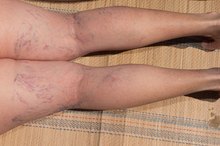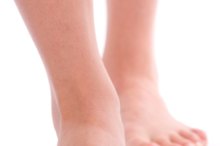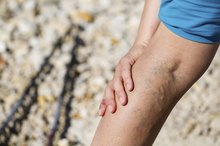Causes of Only One Lower Leg Swelling With Pain
**Pain and swelling affecting only one lower leg most often occur because of an injury to the leg or a medical condition that affects just that leg.
** Several conditions, many of which are serious, can produce these symptoms. Blood clots in leg veins, chronic deep vein insufficiency, infection and lymphatic fluid accumulation are all conditions that may cause just one leg to become sore and swollen.
Deep Vein Thrombosis
A blood clot within a deep vein of the body -- called a deep vein thrombosis (DVT) -- can cause the surrounding area to become painful, swollen and red 2. DVTs can form anywhere, but they most often occur in the lower leg. A DVT of the lower leg is sometimes the result of an injury to the leg that damages the vein. Keeping the leg in one position for a prolonged period of time can cause blood in the vein to move slowly, allowing a clot to form. Certain blood disorders and medications, such as birth control pills, can also make people susceptible to developing a DVT. Medications to thin the blood help prevent clots and are used to treat DVTs once they have developed.
- A blood clot within a deep vein of the body -- called a deep vein thrombosis (DVT) -- can cause the surrounding area to become painful, swollen and red 2.
- Keeping the leg in one position for a prolonged period of time can cause blood in the vein to move slowly, allowing a clot to form.
Chronic Deep Vein Insufficiency
Causes of Right Calf Swelling
Learn More
Chronic deep vein insufficiency occurs when veins are unable to perform their usual job, which is to bring blood back towards the heart. Sometimes the condition occurs for no apparent reason. At other times, it is caused by a previous DVT that permanently damages valves within the vein. Properly functioning valves are important for maintaining the normal flow of blood inside veins. Chronic deep vein insufficiency of the lower leg will cause blood to back up into the lower leg and foot, resulting in swelling. Pain may accompany the swelling, especially when a person is standing or walking. With time, the skin in the area will become red, itchy and scaly. It also becomes fragile and tears easily, resulting in open sores called ulcers.
These ulcers may become inflamed and infected, further increasing swelling and pain. Compression stockings can help reduce swelling caused by chronic deep vein insufficiency.
- Chronic deep vein insufficiency occurs when veins are unable to perform their usual job, which is to bring blood back towards the heart.
Cellulitis
Cellulitis, a bacterial infection that causes pain, redness and swelling of the skin and deeper tissues, often occurs in the lower leg. The area will feel warm and a fever may be present. The skin may develop small red spots or blisters. Cellulitis is caused by a break in the skin that allows bacteria to enter and set up an infection.
**Even tiny openings in the skin, such as those resulting from an insect bite, may lead to cellulitis.
People with a weakened immune system are especially likely to develop cellulitis. ** Antibiotics are needed to treat cellulitis.
- Cellulitis, a bacterial infection that causes pain, redness and swelling of the skin and deeper tissues, often occurs in the lower leg.
Lymphedema
Causes of Red Swollen Feet & Ankles
Learn More
The lower leg is a common site for lymphedema -- the accumulation of lymphatic fluid in an area of the body. Lymphatic fluid is a clear liquid that flows through channels similar to blood vessels. In the leg, these channels bring the fluid to lymph nodes in the groin.
Lymphedema of one leg occurs when lymphatic flow into the nodes is impaired, either because the nodes have been damaged by infection, tumor or radiation therapy or removed during surgery for cancer in the leg or pelvis 4. This leads to swelling, a heavy feeling and pain in the leg. Compression stockings are often used to treat lymphedema. A special massage technique may help move lymphatic fluid out of the leg, but it’s not safe for everyone and should only be used on the advice of a doctor.
- The lower leg is a common site for lymphedema -- the accumulation of lymphatic fluid in an area of the body.
- In the leg, these channels bring the fluid to lymph nodes in the groin.
Injury
An injury that causes pain and swelling in one lower leg is usually obvious. When sufficiently strong, any direct force to the lower leg will produce these symptoms. Bruising will generally be present as well. A sprain or rupture of the calf muscles also causes the lower leg to be sore and swollen. These injuries are most common in athletes, especially during certain activities such as jumping or suddenly changing direction. Fractures of the tibia or fibula -- the two long bones in the lower leg -- produce prominent pain, swelling and bruising. Symptoms caused by a sprain or other injury to the ankle or knee may extend from these joints into the adjacent lower leg.
- An injury that causes pain and swelling in one lower leg is usually obvious.
- When sufficiently strong, any direct force to the lower leg will produce these symptoms.
Seeking Medical Attention
See your doctor if you have pain and swelling in just one leg.
Seek prompt medical care if these symptoms are accompanied by redness or a fever, as these mean that you may have a DVT or infection.
Obtain immediate medical attention if you notice shortness of breath, chest pain or lightheadedness.
These symptoms may indicate that you had a DVT that broke loose and travelled to your lungs. A blood clot in the lungs -- called a pulmonary embolism -- is extremely serious and can lead to collapse or sudden death.
Reviewed by: Mary D. Daley, M.D.
- See your doctor if you have pain and swelling in just one leg.
- These symptoms may indicate that you had a DVT that broke loose and travelled to your lungs.
Related Articles
References
- Chest: Diagnosis of DVT
- Merck Manual Consumer Version: Deep Vein Thrombosis (DVT)
- BMC Infectious Diseases: Prevalence of Concurrent Deep Vein Thrombosis in Patients with Lower Limb Cellulitis -- A Prospective Cohort Study
- National Cancer Institute: Lymphedema
- Merck Manual Professional Version: Deep Venous Thrombosis (DVT)
- Merck Manual Professional Version: Chronic Deep Venous Insufficiency and Postphlebetic Syndrome
Writer Bio
A registered nurse with more than 25 years of experience in oncology, labor/delivery, neonatal intensive care, infertility and ophthalmology, Sharon Perkins has also coauthored and edited numerous health books for the Wiley "Dummies" series. Perkins also has extensive experience working in home health with medically fragile pediatric patients.








